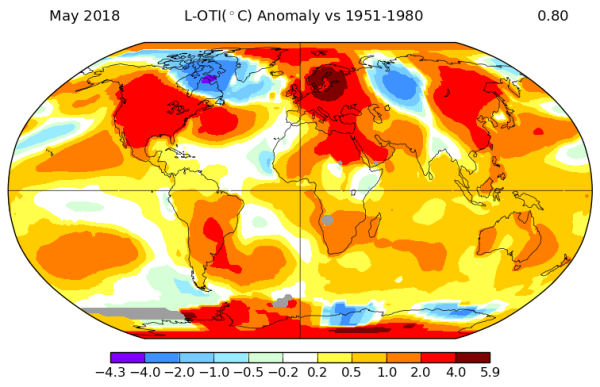NASA:
May Was 4th Hottest on Record
19
June, 2018
According
to reports from NASA
GISS,
May of 2018 was the 4th hottest in the 138 year global temperature
record. This new warmth came as the Equatorial
Pacific began to retreat from a cooling La Nina state —
which, all things being equal, would have resulted in somewhat cooler
than average global temperatures.
(Analysis of global temperature trends based on recent NASA and NOAA reports.)
But
all things are not equal. Greenhouse gasses in
the range of 410 ppm CO2 and 493
ppm CO2e have
created a historically unprecedented heat forcing within the Earth’s
atmosphere. As a result, recent global temperatures have
consistently exceeded
1 C above 1880s levels and have hit as high as 1.5 C above 1880s
levels on a monthly basis and 1.2 C above those levels on an annual
basis.
For
this May, temperatures were about 0.82
C above NASA’s 20th Century baseline or about 1.04 C above 1880s
levels.
This was the fourth hottest May in the global climate record despite
La Nina influences continuing to maintain hold over the global
climate system.
(NASA
global anomalies map shows
distribution of warmer than normal [yellow to red] and cooler than
normal [blue to purple] temperatures across the globe. Note that
warmer than normal conditions dominated.)
Overall,
the greatest above average temperatures were experienced in the
regions of Scandinavia
and Antarctica —
from an anomaly perspective. Meanwhile, significant trough zones
generated counter-trend cool temperatures near Eastern
Canada, over the North Atlantic south of Greenland, and across
Central Siberia.
As we moved into June, some of these zones have shifted or moderated,
with cooler air tending to shift closer to eastern Europe in Asia and
toward the North Atlantic cool water zone (due to melting Greenland
ice) from Eastern Canada.
Looking
ahead, NOAA
is forecasting a 65 percent chance for a return to El Nino conditions
in the Equatorial Pacific by winter of 2018-2019.
With atmospheric CO2 hitting near 410 ppm and overall greenhouse gas
levels hitting near 493 ppm CO2e, this switch to the warm side of
natural variability will again bring with it the risk of record hot
global temperatures, should the NOAA forecast bear out. Though we
should be clear that El Nino is merely a short term aspect of natural
variability that
is riding over the long term warming trend generated
by human produced greenhouse gas emissions, particularly CO2
emissions from fossil fuel burning.
Atmospheric
CO2 Hit 411 Parts Per Million During May
Presently
high levels of atmospheric CO2 and other greenhouse gasses are
already enough to warm the Earth by 1.5 to 2.3 C this Century and 3
to 4.7 C long term. But present path fossil fuel burning could push
that number as high as 3-4 C this Century and 6-8 C or more over
multiple centuries. For this reason, it is urgent that we transition
to renewables such as wind, solar, and EVs as soon as possible.




No comments:
Post a Comment
Note: only a member of this blog may post a comment.